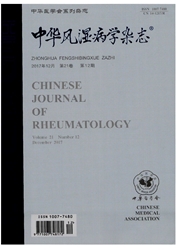

 中文摘要:
中文摘要:
目的 本研究通过比较117例SLE患者和117名匹配的健康志愿者外周血淋巴细胞(PBLC)中5-羟色胺1A(5-HT1A)受体基因(HTR1A)启动子区的甲基化状态及该基因mRNA的表达水平,探讨该基因启动子区的甲基化修饰与SLE的关系.方法 通过亚硫酸氢盐修饰克隆测序法检测目的基因的甲基化状态,用逆转录PCR检测目的基因mRNA的表达丰度.采用x2检验和Fisher确切概率法进行统计分析.结果 SLE患者PBLC中5-HT1A受体基因启动子区的甲基化程度,甲基化胞嘧啶总数(x^2=28.811,P<0.01)和含甲基化胞嘧啶总人数(x^2=16.897,P<0.01)均明显低于健康志愿者,呈现出一种低甲基化状态,尤其在-340位点的甲基化胞嘧啶的总数目SLE组明显少于健康者[1.7%(2/117)与9.4%(11/117),x^2=6.597,P<0.05];同时,SLE患者PBLC中5-HT1A受体基因的mRNA表达丰度明显高于健康者(43±16与0,t=12.82,P<0.01).结论 本研究结果支持5-HT1A受体基因启动子区的低甲基化及该基因的过度表达可能参与了SLE的病理机制,揭示了表观遗传调控可能在SLE的发病机制中起着重要的作用,提供了大脑通过5-羟色胺递质系统与免疫系统发生联系的证据.
 英文摘要:
英文摘要:
Objective To explore the DNA methylation status of the promoter region of HTR1A and the level of HTR1A mRNA in the peripheral blood lymphocytes of 117 systemic lupus erythematosus (SLE) patients and 117 matched healthy controls.Methods Bisulfite modification cloning sequencing was conducted to detect the DNA methylation status of the promoter region of HTR1A.reverse transcription polymerase chain reaction (RT-PCR) was used to test the level of HTR1A mRNA in the peripheral blood lymphocytes.Statistical analyses were performed using Chi-square test and Fisher's exact test.Results The results showed significant hypomethylation of the promoter region of HTR1A in SLE patients compared with the healthy controls (x^2=28.811,P〈0.01 for total mC and x^2=16.897,P〈0.01 for Person with mC),espec.ially at site -340 [1.7% (2/117) vs 9.4% (11/117),x^2=6.597,P〈0.05].The patients also showed a significantly higher HTR1A mRNA level than the controls (43±16 vs 0,t=12.82,P〈0.01).Conclusion Our results support the hypothesis that the hypomethylation of the promoter region of HTR1A and overexpression of HTR1A might contribute to SLE.These results also reveal that epigenetic regulation via the serotonin system may contribute to SLE,and reveal the link between the brain and the immune system.
 同期刊论文项目
同期刊论文项目
 同项目期刊论文
同项目期刊论文
 Abnormal Resting-State Activities and Functional Connectivities of the Anterior and the Posterior Co
Abnormal Resting-State Activities and Functional Connectivities of the Anterior and the Posterior Co 期刊信息
期刊信息
